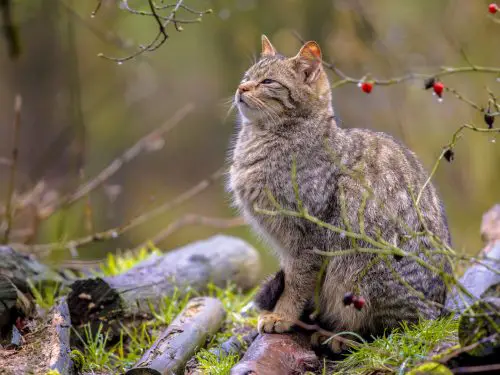No one knows why, but sometimes seagulls will attack cats. They may be protecting their young from the cat, or they’re starving and figured the cat would make a good meal. No matter the reason, knowing that seagulls can be dangerous to cats and taking precautions to keep your feline buddy safe is essential.
There are measures you can take to protect your cat from passing seagulls. Before anything else, remember that spring and summer are peak seagull seasons, so it’s best to keep your cat inside as much as possible. Keep a close check on your cat if it wanders outside, and be prepared to rescue it from any nearby seagulls. Creating loud noises or splashing the seagull with water may also be effective.
Your cat needs immediate attention if a bird attacks it. Damage from a seagull’s beak can be severe, so your cat needs emergency medical attention. Keep your cat quiet and immobile for the time being to reduce the risk of future harm from the seagulls. While it’s upsetting to consider the possibility of damage to one’s pet, knowing the dangers posed by seagulls is essential. Some basic measures will help protect your cat from these potentially dangerous birds.

Do seagulls catch cats?
There would be fewer cats if seagulls regularly caught them for food. Seagulls are fearless of cats and are experts at capturing tiny animals. It is a well-known fact that seagulls will hunt down and consume domestic felines. Seagulls may be able to catch cats for a few different reasons. Seagulls can take advantage of every food source that presents itself. They will take advantage of any simple food source available. Seagulls will prey on cats if there are a lot of them.
Seagulls also congregate in densely populated areas for different purposes. That’s because munchies are frequently dropped. With more mouths to feed, there is a higher probability that some food may be dropped. There would be more cats for the seagulls to catch and devour if there were a lot of cats in the area. The population of cats would naturally decrease if seagulls regularly saw them for food. This would be beneficial because it would mean fewer cats preying on birds and other animals.
Would a seagull attack a kitten?
A seagull came into our town one day and happened upon a kitten having fun in a backyard. The gull dove and caught the cat in its beak. The cat fought the seagull bravely, but it was too powerful. The cat’s cries woke the homeowner, who sprinted to the front door. Seagull released the kitten and took off. Thankfully, the kitten’s injuries were minor enough that they could be treated at the clinic.
This incident demonstrates wild animals’ dangers to domesticated animals and pets. Even while seagulls do not have a record for being particularly aggressive, the one that attacked the kitten did not give it a second thought before doing so. Residents need to be aware of the threats that animals pose in the wild to protect their domesticated animals.
The motivations of a seagull to attack a kitten are many. There’s a chance the bird is guarding its young. It could try to defend its young from the kitten if it thinks it’s in danger. Perhaps the seagull is s and thinks the cat would make a good meal. Unfortunately, seagulls’ reputation as violent birds means they may attack people if they feel threatened. Cats sometimes attack kittens if they feel threatened or need to defend themselves or their territory.
What animals are seagulls afraid of?
Seagulls, like other birds, are terrified of the human faces that are often their natural predators. In the wild, seagulls prey most primarily upon other birds of prey, such as eagles and owls. They’re also frightened of wolves, foxes, and coyotes. Several of my acquaintances who have had issues with seagulls have had success with this owl decoy.
1. Eagles
Several factors might lead to seagulls becoming terrified of eagles. Eagles prey on other birds, so this might be one explanation. Likewise, eagles might be physically larger and stronger than robust seagulls, making the latter nervous of an assault. The prospect of being devoured by eagles is a legitimate concern for seagulls. One possible explanation for the gulls’ fear of eagles is that eagles pose a threat to their food supply. Eagles may scare away seagulls because they may grab the food the seagulls have been working so hard to obtain.
2. Owls
There are several reasons why owls inspire terror in seagulls. Why? Because seagulls are a tasty treat for predatory owls. Owls awake at night when gulls are resting, another factor. As a result, owls may sneak up on their prey and strike without warning. It’s also tricky for gulls to hear an owl since owls are so quiet when they fly. Finally, owls’ talons and beaks are just as sharp, allowing them to cause considerable harm to seagulls. Combining these variables makes it easy to see why seagulls are so terrified of owls.
3. Wolves
Seagulls’ apprehension of wolves might stem from several factors. A possible explanation is that wolves hunt seagulls, and the gulls are easy food for them. One possible reason is that wolves have too much physical strength for the little seagulls. Wolves also frequently travel in packs. Thus, it’s likely that a lone seagull would be outnumbered and overpowered by a whole bunch of wolves. Finally, seagulls are likely to avoid wolves because of the negative connotations of this species.
4. Foxes
Seagulls’ apprehension of foxes is understandable for a variety of reasons. The fact that foxes are predators and gulls are prey might be a contributing factor. It’s also possible that foxes’ penchant for killing and eating seagulls has a role. In addition, foxes are far more significant and scarier than seagulls. Lastly, foxes may have a negative connotation for seagulls since the birds have had negative prior experiences with them. It is unclear why seagulls are so scared of foxes, yet it is a well-known phenomenon.
5. Coyotes
A combination of several variables causes Seagulls’ fear of coyotes. Coyotes are predators, and seagulls provide an easy meal for them to take down. Because they are significantly more significant than birds, coyotes can injure or kill seagulls. There are a lot of animals that prey on seagulls. As a result, these birds must maintain constant vigilance.
Coyotes, like humans, have a morbid fear of seagulls. There have been claims that seagulls have attacked and killed coyotes in some areas. They will also have their food source stolen from them by the animals. Because of the aggressive character of seagulls, it is common for coyotes to avoid encounters with these birds.
Do birds try to attack cats?
Birds probably wouldn’t fare well if they tried to attack cats. In addition to their speed and agility, cats have claws that can cause fatal injury to birds. Felines are usually found on the floor or in trees, making it difficult for birds to approach them, while birds have a hard time getting near to cats because they are usually in the air. A bird might attempt to assault a cat, but the cat would likely merely swat it away.
As a result, while birds may attempt to attack cats, they probably won’t be successful very often. One possible explanation could be that the bird is attempting to defend its chicks from the cat. The bird might also be merely protecting its territory, a distinct possibility. As you may imagine, neither the cat nor the bird like this situation.
When faced with an attack from a bird, cats normally fare well in a defensive standoff, but occasionally the bird will prevail. It’s important to rapidly separate your cat from the bird if the latter is assaulting it. Your cat may need medical treatment if the bird is very hostile. Birds rarely attack cats, but when they are, it may be a terrifying experience for both of them. There is a risk. Therefore you should be aware of it and take precautions to keep your cat safe.
Are Cats Safe from Bird Attacks, Including Eagles?
Cats often encounter dangers outdoors, but are they safe from eagles’ predation on feline pets? While cats are agile and can escape many predators, eagles pose a significant threat due to their size and hunting abilities. It is crucial for cat owners to ensure their pets’ safety by keeping them supervised or providing protected outdoor spaces to prevent potential bird attacks.
Are Turkey Vultures and Seagulls Equally Likely to Attack Cats?
Turkey vultures and their impact on cats differ from seagulls. While seagulls occasionally swoop down on smaller prey, turkey vultures primarily feed on carrion. They are less likely to attack healthy cats, as their diet consists of carcasses. Conversely, seagulls may be more willing to snatch small animals, including cats.
Conclusion
In conclusion, there are a few hypotheses about why gulls attack cats, but no one knows. One explanation is that the gulls attempt to defend their young from harm. Some have postulated that this might be because seagulls view cats as threatening their food supply. Whatever the case may be, protecting your cat from these hostile birds is a top priority.
There are steps you may take to safeguard your cat against gulls. As a first step, confine your cat to the house. Only allow your cat outside under close supervision if you really must. Don’t tempt the seagulls by leaving your cat’s water and food outside—bring it inside last; if you witness a seagull assaulting your cat, attempt to frighten it away by creating noise or tossing anything at it; with some caution, protect your cat from being attacked by seagulls.









